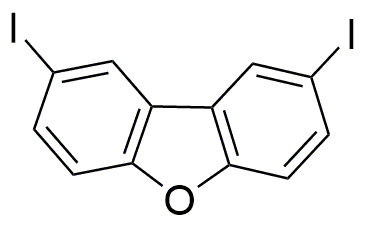2,8-Diiododibenzofuran is widely utilized in research focused on:
- Organic Electronics: This compound is used in the development of organic light-emitting diodes (OLEDs), enhancing the efficiency and color range of displays in consumer electronics.
- Pharmaceuticals: Its unique structure allows for the synthesis of potential drug candidates, particularly in targeting specific biological pathways, making it valuable in medicinal chemistry.
- Photovoltaics: The compound plays a role in creating organic solar cells, contributing to renewable energy solutions by improving light absorption and conversion efficiency.
- Material Science: It is utilized in the production of advanced materials with specific optical properties, beneficial for applications in sensors and imaging technologies.
- Research in Halogenated Compounds: The compound serves as a model for studying the effects of halogenation on chemical reactivity and stability, providing insights for chemists in various fields.
Información general
Propiedades
Seguridad y normativas
Aplicaciones
2,8-Diiododibenzofuran is widely utilized in research focused on:
- Organic Electronics: This compound is used in the development of organic light-emitting diodes (OLEDs), enhancing the efficiency and color range of displays in consumer electronics.
- Pharmaceuticals: Its unique structure allows for the synthesis of potential drug candidates, particularly in targeting specific biological pathways, making it valuable in medicinal chemistry.
- Photovoltaics: The compound plays a role in creating organic solar cells, contributing to renewable energy solutions by improving light absorption and conversion efficiency.
- Material Science: It is utilized in the production of advanced materials with specific optical properties, beneficial for applications in sensors and imaging technologies.
- Research in Halogenated Compounds: The compound serves as a model for studying the effects of halogenation on chemical reactivity and stability, providing insights for chemists in various fields.
Documentos
Hojas de datos de seguridad (HDS)
La SDS proporciona información de seguridad completa sobre la manipulación, el almacenamiento y la eliminación del producto.
Especificación del producto (PS)
La PS proporciona un desglose completo de las propiedades del producto, incluida la composición química, el estado físico, la pureza y los requisitos de almacenamiento. También detalla los rangos de calidad aceptables y las aplicaciones previstas del producto.
Certificados de análisis (COA)
Busque certificados de análisis (COA) ingresando el número de lote del producto. Los números de lote y de partida se pueden encontrar en la etiqueta de un producto después de las palabras "Lote" o "Lote".
Número de catálogo
Número de lote/lote
Certificados de origen (COO)
Este certificado de origen confirma el país en el que se fabricó el producto y también detalla los materiales y componentes utilizados en él y si se deriva de fuentes naturales, sintéticas u otras fuentes específicas. Este certificado puede ser necesario para cumplir con las normativas aduaneras, comerciales y regulatorias.
Número de catálogo
Número de lote/lote
Hojas de datos de seguridad (HDS)
La SDS proporciona información de seguridad completa sobre la manipulación, el almacenamiento y la eliminación del producto.
DownloadEspecificación del producto (PS)
La PS proporciona un desglose completo de las propiedades del producto, incluida la composición química, el estado físico, la pureza y los requisitos de almacenamiento. También detalla los rangos de calidad aceptables y las aplicaciones previstas del producto.
DownloadCertificados de análisis (COA)
Busque certificados de análisis (COA) ingresando el número de lote del producto. Los números de lote y de partida se pueden encontrar en la etiqueta de un producto después de las palabras "Lote" o "Lote".
Número de catálogo
Número de lote/lote
Certificados de origen (COO)
Este certificado de origen confirma el país en el que se fabricó el producto y también detalla los materiales y componentes utilizados en él y si se deriva de fuentes naturales, sintéticas u otras fuentes específicas. Este certificado puede ser necesario para cumplir con las normativas aduaneras, comerciales y regulatorias.


